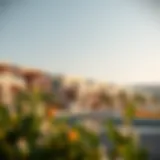Exploring the Saleh Building in Dubai's Property Market
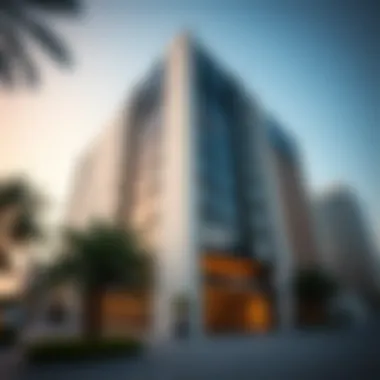
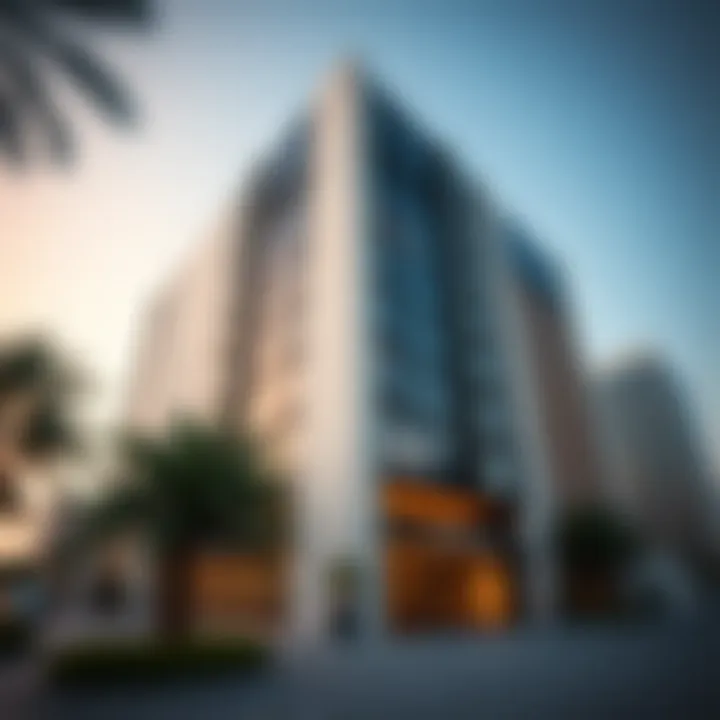
Intro
The Saleh Building weaves itself intricately into the fabric of Dubai’s burgeoning real estate scene. A striking blend of modern architecture and cultural elements, this edifice is not merely a structure but a testament to the rapid evolution of the city it inhabits. For investors, agents, buyers, and even casual observers, understanding the Saleh Building's role in the real estate landscape can illuminate broader trends within Dubai's dynamic market. This article journeys through its architectural heartbeat, historical essence, investment allure, and its impact on the surrounding community.
Market Trends and Analysis
Current Market Conditions
As we look at the state of Dubai’s real estate, it resembles a bustling marketplace filled with opportunities. The Saleh Building, in this context, stands out as a beacon for investors keen on maximizing their engagement within the region. Recent trends indicate a shift towards sustainable developments and mixed-use properties in Dubai, with the Saleh Building capturing this spirit through its infrastructure that balances residential and commercial spaces.
Investors should note that there’s a rising demand for quality accommodations paired with top-tier facilities. As the city attracts more expatriates and businesses setting their sights on growth, properties like the Saleh Building are increasingly sought after. Such structures are not merely buildings but hubs of activity that contribute to the neighborhood's development and appeal, drawing in higher living and rental rates.
Future Projections and Opportunities
Looking ahead, analysts suggest that the horizon for Dubai's real estate market shines brightly. With events like Expo 2020 revitalizing interest in the region, it appears the Saleh Building will benefit directly from this influx of attention and investment. Market experts predict significant growth in rental yields and property values. The proximity of the Saleh Building to key amenities and transport links positions it well to capture the influx.
"For anyone eyeing Dubai’s real estate landscape, investing in key properties like the Saleh Building offers potential rewards that echo beyond monetary gains."
Investment Strategies
Best Areas for Investment
Investors keen on maximizing their portfolios should consider various neighborhoods surrounding the Saleh Building. Notables include areas like Downtown Dubai, which, while often associated with high-stakes investment, offers unparalleled returns owing to its constant demand. Similarly, Al Quoz is attracting attention for its blend of commercial and residential spaces, often sought by innovative businesses and creatives.
Tips for Property Investors
To navigate the intricate web of Dubai's property market effectively, here are some pointers:
- Conduct Due Diligence: Research property histories and neighborhood dynamics.
- Networking is Key: Forge connections with local agents who possess insider knowledge.
- Consider Up-and-coming Areas: Investing in areas like Dubai Marina can yield high returns as infrastructure improves.
- Leverage Financing Options: Explore various financing options to enhance your investment capacity.
- Keep Track of Market Movements: Subscribe to real estate news platforms to stay informed about the current conditions.
Overview of the Saleh Building
The Saleh Building occupies a prominent place in Dubai's ever-evolving real estate landscape. It is not just another high-rise; it sets the stage for understanding how architectural ambition, market dynamics, and urban development intertwine in this bustling metropolis. For investors, the building stands out as a bellwether of not just immediate investment opportunities but also future trends reflective of the city's growth and evolution. Recognizing the significance of the Saleh Building can inform various stakeholders, from real estate agents looking to attract clients, to expatriates seeking their ideal homes, to analysts assessing property values in the region.
Main elements to consider regarding the Saleh Building include:
- Its innovative architectural design, which incorporates modern aesthetics while respecting local traditions.
- The location's strategic advantages, making it accessible for both residents and businesses.
- The financial implications it holds for investors, given its historical appreciation and rental yields.
"The Saleh Building is more than a structure; it's a narrative of Dubai's ambition to blend innovation with tradition."
In exploring the Saleh Building, one must delve into the architectural significance and the accessible location that enhance its desirability. From the curvature of its facade to the modern materials used, each design choice reflects an intention to not only house people and businesses but also to inspire awe within a competitive real estate market. Furthermore, its location offers an unparalleled range of transportation options, which is crucial for both the day-to-day lives of residents and for businesses aiming to thrive in today's fast-paced environment.
Historical Context
The Saleh Building plays a pivotal role not only in the skyline of Dubai but also in embedding the historical context that shapes its identity. Understanding this historical framework reveals how the building reflects the broader evolution of the city's real estate landscape. This backdrop is fundamental for investors, agents, and anyone keen on navigating the complexity of Dubai's property market.
Construction Timeline
The origins of the Saleh Building trace back to the early 2000s, a period when Dubai was metamorphosing, emerging as a global hub for finance, tourism, and real estate. The construction began in 2003, with its completion marking a significant step in the growth of the area. Here’s a brief overview of the construction phases:
- 2003: Groundbreaking and initial preparatory work began.
- 2004: Structural framework was erected, showcasing innovative designs that sought to blend functionality with aesthetics.
- 2007: The building reached full height, symbolizing Dubai’s rapid economic advancement.
- 2008: Final touches and interior finishing were completed, allowing the building to open its doors to businesses and residents alike.
This timeline underscores the rapid pace of development in Dubai, reflecting how structures like the Saleh Building have contributed to the city's architectural narrative.
Evolution Over the Years
Since its completion, the Saleh Building has undergone various adaptations that reflect shifting market demands and urban planning initiatives. Originally designed for commercial use, the building saw a gradual influx of mixed-use spaces, attracting a diverse range of tenants. In 2012, it became a center for tech startups, capitalizing on Dubai's push to become a tech haven.
Key moments in this evolution include:
- 2015: Renovation efforts aimed to modernize facilities, ensuring alignment with contemporary standards and sustainable practices.
- 2018: A shift towards co-working spaces, catering to the growing freelance economy and startups, which further diversified the tenant mix.
- 2020: The implementation of smart building technologies that cater to the needs of modern businesses while enhancing energy efficiency.

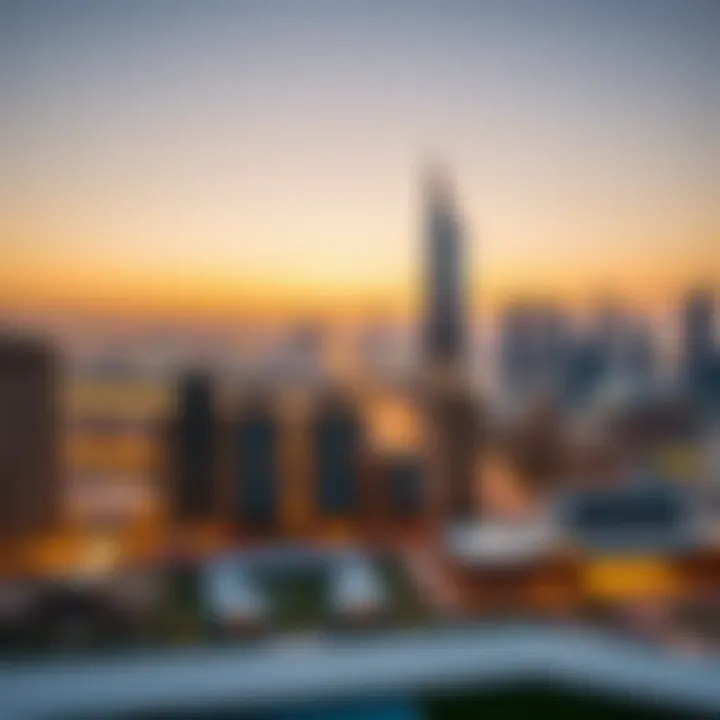
Overall, the Saleh Building not only stands as a fixture in Dubai's skyline but also represents the dynamic changes the city has experienced over the last two decades. Its adaptability mirrors the real estate market's response to global trends, economic shifts, and community needs, establishing it as a critical player in the evolving narrative of Dubai.
Investment Opportunities
The real estate market in Dubai is as vibrant as its skyline, with numerous structures vying for attention. Among these, the Saleh Building holds a distinct position. Understanding the investment opportunities associated with this building is crucial for potential investors, agents, and buyers alike. This section explores the various facets of investing in the Saleh Building and why it should be on the radar for anyone keen on the Dubai property scene.
Real Estate Market Trends
Analyzing the real estate market trends in Dubai isn't just important; it’s somewhat critical for making informed decisions. The Saleh Building finds itself amidst a wave of transformation and growth. Recent years have shown a steady increase in demand for commercial and residential properties, driven by a soaring expatriate population and a thriving economy. In 2022 alone, Dubai's property market marked a growth rate of approximately 70% in transactions, showcasing its resilience and allure.
Among investors, commercial spaces like those in the Saleh Building are particularly attractive. With a myriad of businesses flocking to the area, properties here experience lower vacancy rates compared to the city's outskirts. Initial indicators suggest a shift toward investing in buildings that combine both residential and commercial spaces, enhancing foot traffic, and therefore, profitability. Factors influencing these trends include:
- Government Initiatives: Various policies to encourage foreign investment have made it easier for non-residents to acquire property in Dubai.
- Cultural Melting Pot: The diverse community drives demand for varied amenities and services, making properties in well-located buildings like the Saleh Building proffer fruitful returns.
- Expo Influence: Events such as the Expo 2020 have spurred long-term growth in real estate transactions.
Potential ROI for Investors
When it comes to return on investment (ROI), the Saleh Building stands out. Investors often look for properties with high potential returns, and this structure ticks several boxes. The anticipated ROI can be directly linked to a few key aspects.
- Strategic Location: Being positioned in a bustling area ensures a constant flow of tenants—both residential and commercial. This enhances the rental income potential, promising an attractive yield.
- Capital Appreciation: With urban development in full swing around the Saleh Building, property values are likely to appreciate over time. Historical data suggests that properties in stacked-up areas can appreciate anywhere from 5% to 20% annually, making this not just a property purchase but a long-term investment.
- Flexible Spaces: The building's design allows for versatile usage. This adaptability attracts a diverse tenant base, from startups to established businesses, showcasing sustainable demand.
Investors should bear in mind the market dynamics and keep a close watch on how external factors such as global economic trends and local regulations shape the future of their investments.
"Investment in real estate is not just about property—it's about understanding cultural dynamics, market trends, and potential growth."
Design Features
The Saleh Building is not just another edifice in Dubai’s skyline; it reflects the breathtaking fusion of functionality and aesthetic appeal. Particularly for potential investors, understanding the design features of this building is crucial. A building’s design can significantly impact its market value and attractiveness to potential tenants or buyers. With a combination of cutting-edge architecture and thoughtful environmental planning, the Saleh Building stands as a testament to modern design principles.
Interior Layout
The interior of the Saleh Building is characterized by a design that promotes fluidity and practicality. With spacious, open floor plans, the layout caters to both residential and commercial needs. The lobby is adorned with high ceilings and modern fixtures, which immediately gives an impression of luxury and space. Each floor is thoughtfully zoned, allowing for both individual and communal spaces, catering to a diverse range of occupants.
Key aspects of the interior layout include:
- Flexible Space Options: Tenants can customize their office areas or homes as per their requirements, a flexibility that is often a must-have in today’s fast-paced environment.
- Natural Light Integration: Large windows and strategically placed skylights fill the spaces with natural light, providing both energy efficiency and a pleasant atmosphere.
- Sustainable Materials: The use of eco-friendly materials is apparent throughout, minimizing the building’s carbon footprint and enhancing indoor air quality.
This structure not only accommodates the current demands of urban living but is also designed to adapt as those needs evolve. Investors recognizing these features may find significant appeal in the market.
Exterior Aesthetic
The exterior of the Saleh Building is striking, featuring a blend of modern architectural trends and cultural nods that echo Dubai’s rich history. The facade incorporates glass and steel, which reflects the surrounding skyline while contrasting it with traditional design elements that hint at local architectural heritage.
Notable features of the exterior aesthetic:
- Sleek Facade: The dynamic lines and shimmering surface create a visually stunning effect, ensuring it stands out in a city famed for its skyscrapers.
- Landscaped Surroundings: Outdoor areas are tastefully landscaped, providing green spaces which lessen urban congestion and enhance the livability of the area.
- Lighting Features: At night, the building is beautifully illuminated, turning it into a beacon of modernity and elegance amidst the historic backdrop of Dubai.
"The building is not merely a place to work or live, it engages with the city at a fundamental level, embodying both past and present."
Overall, the design features of the Saleh Building not only satisfy aesthetic standards but also promote functionality. For investors, these attributes signify a promising investment opportunity, as attractive buildings tend to draw in tenants more effectively, fostering a thriving community in Dubai.
Learn more about architectural trends in Dubai and their impact on real estate investments.
Neighborhood Dynamics
The concept of neighborhood dynamics plays a crucial role in understanding the real estate landscape surrounding the Saleh Building. This aspect not only details the surrounding environment but also encompasses the socio-economic factors that influence investment decisions. In an ever-expanding metropolis like Dubai, grasping neighborhood dynamics can guide potential investors on where to allocate resources effectively, ensuring that their investments yield desirable returns.
Surrounding Amenities
When we look at the Saleh Building, it's clear that convenience and accessibility are the name of the game. The presence of nearby amenities can dramatically enhance the value of real estate. For investors and tenants alike, having essential services such as grocery stores, hospitals, and schools within close proximity can significantly improve quality of life.
- Retail Outlets: The area around the Saleh Building boasts a variety of shopping options, from plush boutiques to essential supermarkets. For instance, having a Carrefour nearby eases everyday shopping needs.
- Recreational Spaces: Parks and gyms contribute to a well-rounded lifestyle, providing spaces for relaxation and fitness. This neighborhood offers local parks where families can unwind.
- Transport Links: Accessibility is pivotal. The Saleh Building connects easily to major highways and public transport routes, making commuting hassle-free for residents and businesses.
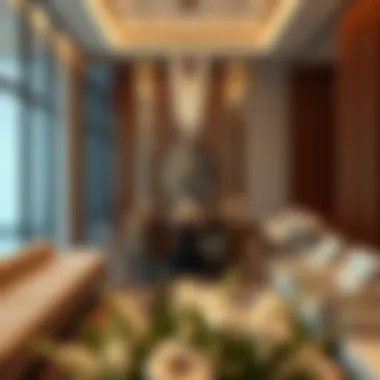

With all these features combined, it's evident why surrounding amenities can make or break a property’s allure. Investors keep a keen eye on how these factors interplay with property values and demand.
Community Engagement
Community engagement is not just a buzzword; it's a pillar of what makes a neighborhood vibrant and livable. The interactions among residents can lead to a collective spirit, fostering connections that enhance the overall atmosphere of the area surrounding the Saleh Building. For an astute buyer or investor, understanding how community dynamics work can be as crucial as knowing market trends.
- Local Events: Frequent community events, such as farmers' markets or cultural festivals, can draw residents together and elevate neighborhood interest. This sense of belonging can be a significant selling point for potential tenants.
- Networking Opportunities: Opportunities for professional networking increase not only individual growth but can also enhance neighborhood value. For instance, business associations and local clubs can attract like-minded individuals to the area, driving up desirability.
- Feedback Channels: Effective communication channels between residents and local government empower citizens. Residents often become active participants in local governance, which may lead to improvements in public services and amenities, steadily increasing the property values in the area.
Thus, community engagement isn't merely a social nicety; it significantly shapes the market dynamics and influences investment decisions around the Saleh Building, making its understanding essential for anyone looking to invest in Dubai's real estate sector.
Regulatory Framework
Understanding the regulatory framework surrounding the Saleh Building is crucial for anyone engaged in the Dubai real estate scene. The regulatory landscape not only ensures that buildings comply with safety and environmental standards but also shapes investment opportunities. Investors, agents, and buyers alike need to grasp how these regulations can influence their decisions.
The laws and standards in Dubai aim to strike a delicate balance between commercial interests and urban development, affecting everything from construction practices to property management. This framework can serve as a double-edged sword; while it provides protections that enhance property values, it can also impose significant obligations on property owners.
Key Aspects of the Regulatory Framework
- Compliance Requirements: Adhering to local building codes and safety standards is non-negotiable. Those who fail to comply risk penalties, which can negatively impact both reputation and investment returns.
- Environmental Considerations: With Dubai's growing emphasis on sustainability, buildings like the Saleh Building must meet green building standards. This not only aligns with global trends but may offer financial incentives for compliance.
- Impact on Lease Agreements: Rental properties must follow regulations that dictate lease lengths, tenant rights, and property management practices. Understanding these rules is key for both tenants and landlords.
Building Codes and Standards in Dubai
Building codes in Dubai are not just a bureaucratic hassle; they are critical for ensuring the structural integrity and safety of buildings like the Saleh Building. These codes encompass various aspects such as materials used, design elements, and energy efficiency.
- Safety Standards: From fire safety to electrical installations, strict adherence to codes is enforced to protect lives and property. Imagine owning a building that skimped on essential safety features; the risks are simply too great.
- Sustainability Standards: Increasingly, Dubai is focusing on green building techniques. The Saleh Building has adopted several measures that resonate with these standards, from energy-efficient systems to water conservation techniques. Compliance could translate into lower operating costs and increased desirability.
- Quality Control: Inspections are mandated at various stages of construction, ensuring that any issues are identified and rectified before they become significant problems. This quality assurance helps to maintain a high construction standard across Dubai's real estate projects.
Impact on Property Management
The regulatory framework has a substantial impact on how properties are managed in Dubai. Investors must navigate a web of laws that dictate everything from routine maintenance to tenant relations.
Considerations for Property Managers:
- Tenant Rights and Lease Regulations: Landlords need to be aware of tenants' rights, which are protected under Dubai law. Disputes can arise if landlords are uninformed, leading to possible legal action. Knowledge of local laws can smooth these interactions.
- Maintenance Requirements: Regular maintenance is not just good practice; it's often mandated by law. Compliance ensures that properties remain livable and marketable. Indeed, failing to maintain standards can lead to diminished property values.
Benefits of Robust Property Management:
- Increased Tenant Satisfaction: Good management that adheres to regulations contributes to tenant retention, affecting overall profitability.
- Long-Term Client Relationships: Stick to the rules, and trust from clients can develop over time, enhancing your reputation in an often crowded market.
- Higher Rental Yields: Properties managed with attention to regulatory compliance are often seen as more reliable, which can command higher rents in a competitive market.
"In Dubai's evolving landscape, understanding rules can turn potential pitfalls into opportunities."
This framework is vital not only for compliance but for fostering a trustworthy environment for all parties involved in the real estate chain. To remain competitive, investors must proactively engage with these regulations, turning them from obstacles into advantages.
Challenges Facing the Saleh Building
The Saleh Building, while a beacon of architectural prestige and a major player in Dubai's real estate landscape, faces several formidable challenges that could impact its standing and investment potential. Understanding these challenges is crucial for investors, agents, and analysts alike. It is beneficial to comprehend the complexities surrounding market fluctuations and environmental sustainability initiatives—issues that are even more pressing in a city known for its rapid development and economic dynamics.
Market Volatility
Dubai's property market has witnessed both dramatic highs and unexpected lows. Market volatility presents a significant challenge for the Saleh Building. Investors need to be wary of sudden shifts in demand and pricing trends, which can reshape the landscape overnight. Several factors contribute to this volatility:
- Economic Conditions: Global economic downturns can impact buyer sentiment. Investors may hesitate to commit to large purchases, affecting overall market demand.
- Regulatory Changes: As government policies evolve to enhance transparency and improve investor protections, existing and potential investors need to understand how these changes affect property values. A sudden overhaul in real estate policies could quickly make once desirable features less appealing.
- Competitor Growth: The emergence of new developments can alter the competitive landscape, pushing the Saleh Building to re-evaluate its value proposition. With so many high-profile projects in Dubai, maintaining a unique selling point is essential to attract buyers.
Instead of viewing these fluctuations as barriers, savvy investors can see opportunities for strategic investment, should they align their decisions with emerging trends.
Sustainability Concerns
In an age where environmental issues dominate discussions, sustainability has taken center stage. For the Saleh Building, addressing sustainability concerns is not merely a compliance matter, but an integral feature for long-term viability. Here are a few points that need attention:
- Energy Efficiency: Increasing the energy efficiency of the building is paramount. Innovations in HVAC systems and the incorporation of energy-saving technologies can enhance the building’s appeal to environmentally-conscious investors.
- Sustainable Materials: Utilizing sustainable materials during renovations can also make a significant impact. This practice not only reduces the building's carbon footprint but also showcases a commitment to responsible development.
- Regulatory Pressures: More regulations are emerging focusing on sustainability standards. Adhering to these can potentially increase operational costs, but they also represent an opportunity to enhance the property’s appeal.
As the market shifts towards greater eco-consciousness, the Saleh Building must innovate and evolve in response to these sustainability calls, ensuring it does not fall behind competitors who are actively leveraging these principles to enhance their own market positions.

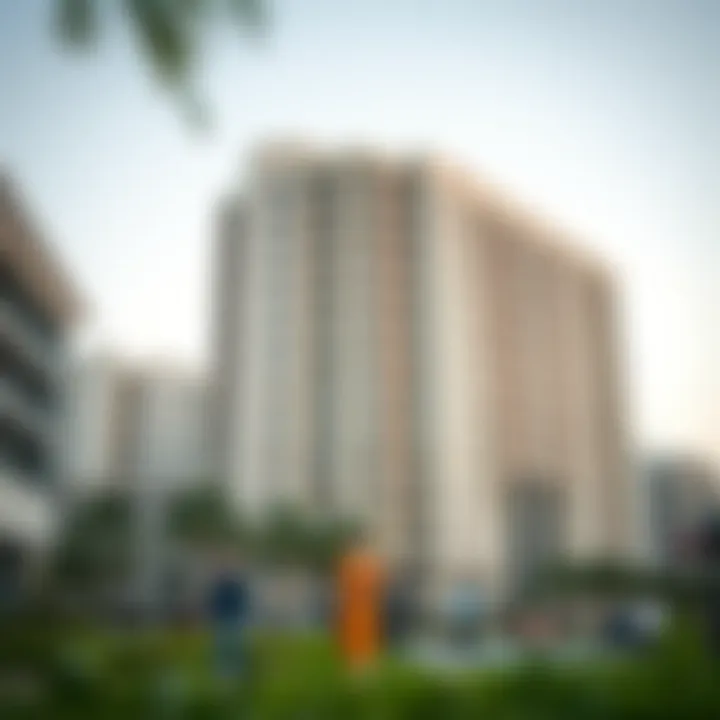
"Sustainability isn't about being perfect. It's about doing the best you can with the resources available to you."
– Unknown
Navigating these challenges requires a nuanced understanding of both local market conditions and global trends. By addressing market volatility and prioritizing sustainability, the Saleh Building can not only safeguard its value but also position itself as a leader in responsible investment, appealing to a demographic that values both profitability and social responsibility.
Future Prospects
The Future Prospects section of this article is pivotal in understanding the evolving landscape surrounding the Saleh Building. This chapter dives into what's on the horizon for this iconic structure, examining both upcoming developments and potential upgrades that could redefine its role in Dubai's real estate narrative. As the city continues to grow, the Saleh Building must adapt to the changing demands of its occupants and the broader market, making it a pertinent subject for investors and stakeholders alike.
Upcoming Developments
Dubai’s skyline is a testament to architectural ambition and ongoing innovation. In this bustling environment, the Saleh Building is eyeing several key initiatives that signal its readiness to evolve. The recent announcements concerning urban revitalization projects nearby suggest that the building could easily benefit from improved infrastructure and new amenities.
- Transport Enhancements: Currently, plans are being discussed to upgrade public transport links in the vicinity, which could significantly increase footfall and accessibility for both residents and visitors.
- Cultural Integrations: There are discussions around integrating cultural festinvals and markets that focus on local artisans, enhancing the community vibe and attracting tourists.
- Mixed-Use Developments: With a trend moving towards mixed-use spaces, the Saleh Building might incorporate retail or leisure options on its ground levels, a move that can create additional revenue streams.
These developments promise to elevate the surrounding environment and, by extension, raise the profile of the Saleh Building itself.
Potential Upgrades and Renovations
As the future unfolds, potential upgrades and renovations to the Saleh Building stand out as critical elements in its sustainability and relevance. Factors contributing to these possibilities range from technological advancements to changing market demands.
- Smart Building Technologies: Integration of smart technologies can enhance the building’s efficiency. Systems that control lighting, heating, and security, working together, can significantly reduce operating costs and appeal to tech-savvy tenants.
- Green Renovations: Sustainability isn't just a buzzword; it's a necessity. Improvements that focus on energy-efficient systems and eco-friendly materials can make the building more attractive to environmentally conscious investors.
- Aesthetic Revamps: A facelift in terms of both interior and exterior design elements can reinvigorate interest in the property. Simple enhancements like modern façades or updated communal spaces can transform perceptions.
The importance of embracing change cannot be overstated. As new trends emerge and the desires of tenants evolve, the Saleh Building's forecasted upgrades will position it as a forward-thinking choice in Dubai’s competitive real estate landscape.
Comparative Analysis
In examining the Saleh Building, conducting a comparative analysis provides depth and context to its standing within Dubai's dynamic real estate market. This analysis serves as a lens to evaluate the building's unique attributes against its counterparts. By contrasting similar structures and market players, stakeholders can glean insights into the architectural and commercial merits that the Saleh Building brings to the table.
A thorough comparative analysis is not just about apples to oranges comparisons; it often unearths reasons behind a property’s valuation and desirability. Knowing how the Saleh Building stacks up against its neighbors helps investors, buyers, and agents identify opportunities and risks. Certain key elements come into play in this exploration:
- Architectural Style: The aesthetic appeal plays a significant role in attracting both tenants and investors. How does the Saleh Building's design measure up against that of similar landmarks in the vicinity? Does it exhibit a modern flair or showcase traditional elements that resonate with regional culture?
- Amenities: Proximity to essential amenities like shopping centers, schools, healthcare, and public transport can influence desirability. Insights into how the Saleh Building's offerings compare with others in the district can guide prospective investors.
- Pricing Trends: Examining current rental rates and property prices relative to similar buildings allows stakeholders to understand market positioning. It's not just about what the property is worth today, but how it has performed over time against its competitors.
The implications of this analysis ripple outwards, allowing potential investors and buyers to avoid missteps and capitalize on emerging market trends.
Similar Buildings in the Area
A careful look at similar buildings in the area reveals a tapestry of architectural diversity and investment potential. For instance, the Burj Views Towers and the City Walk developments are significant landmarks within close proximity to the Saleh Building. Both offer a blend of residential and commercial options catering to a variety of tenants.
- Burj Views Towers: Featuring stunning views of the iconic Burj Khalifa, this residential complex attracts families and affluent individuals alike. The rental prices here typically hover in the same range as those in the Saleh Building, making it a direct competitor.
- City Walk: This mixed-use development combines retail, residential, and leisure spaces, creating a vibrant living atmosphere. It is noted for its high foot traffic, which can be a double-edged sword for similar buildings nearby, including the Saleh Building.
- Dubai Marina Towers: Known for their luxurious amenities and breathtaking waterfront views, these towers cater primarily to expatriates and affluent locals, commanding higher rental prices than some other buildings within the same radius. This heightens the competitive environment.
Understanding the positioning of the Saleh Building among such structures can assist stakeholders in realizing its unique selling propositions and areas that might benefit from future enhancements.
Market Position Relative to Competitors
Evaluating the Saleh Building's market position relative to its competitors allows a deeper understanding of its strategic advantages and possible disadvantages. In a city like Dubai, where real estate is a hotbed of fluctuating price trends and varying demand, this positioning can be a game changer.
- Visitor Appeal: The Saleh Building often draws in not just residents but also businesses looking to establish a presence in Dubai. Its accessibility and proximity to major attractions unlike competitors that might cater solely to one demographic may set it apart in the bustling marketplace.
- Investment Performance: Keeping an eye on what properties in the vicinity are returning in terms of investment yields provides critical information. For example, properties like the Downtown Dubai area are renowned for their high demand and thus higher returns, but they come with a higher entry cost. The Saleh Building’s moderate pricing could be a strategic entry point for new investors, offering them a chance to tap into this lucrative market.
- Reputation and Branding: Lastly, the brand perception of the Saleh Building compared to competitors can sway investor decisions. Properties that consistently uphold high standards of management and tenant satisfaction naturally engender more trust.
In summarizing this analysis, one finds that the comparative study of the Saleh Building generates a more vivid picture of its place in Dubai's real estate ecosystem. The attention to detail in understanding its competition brings forth essential insights for any investor or agent looking to make educated decisions in this expansive market.
Closure
The exploration of the Saleh Building extends beyond its physical structure. It embodies the dynamism of Dubai's real estate market, making it a pivotal player in the local landscape. Understanding this building’s significance is not only about appreciating its architectural beauty or historical importance; it’s also about recognizing its potential as an investment opportunity.
With the evolving market conditions, investors must consider various factors that impact the property’s viability. These include the trends within the surrounding neighborhoods, the building’s maintenance history, and potential return on investment. Additionally, the regulatory factors at play can't be ignored as they directly influence property management and future developments.
In a city that continuously pushes the envelope in terms of design and investment strategy, the Saleh Building stands as a testament to the vibrant real estate scene in Dubai. Investors, agents, and expatriates alike can glean valuable insights from its standing in the market, guiding informed decisions in their ventures.
"A building is not just a structure; it is an ecosystem of aspirations and investments."
Key Takeaways
- Architectural Charm: The Saleh Building is renowned for its stunning design, making it a landmark in Dubai. Its aesthetic appeal adds value that goes beyond mere function.
- Investment Potential: Investing in this structure presents a unique opportunity, particularly due to its strategic location and the ongoing developments in the vicinity.
- Community Role: The building plays an integral part in the local community, impacting everything from social interactions to economic activities, which should be considered by potential investors.
Final Thoughts on Investment Viability
The Saleh Building offers a promising landscape for investors. Its blend of architectural innovation and historical relevance positions it uniquely within the Dubai market. As trends fluctuate, key considerations should include ongoing neighborhood developments and regulatory frameworks that impact property values. These elements, when analyzed collectively, portray the building as a sound investment choice for discerning buyers.
